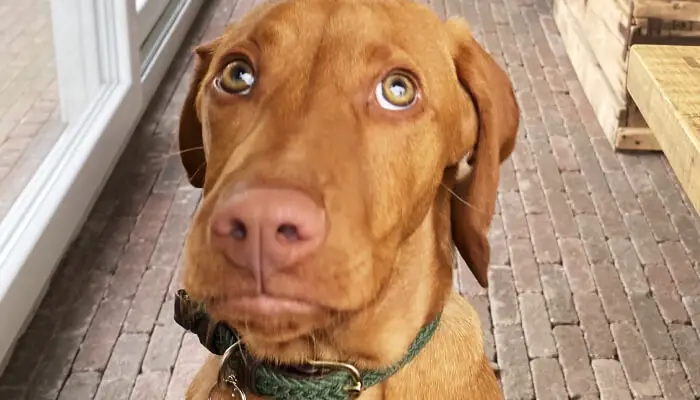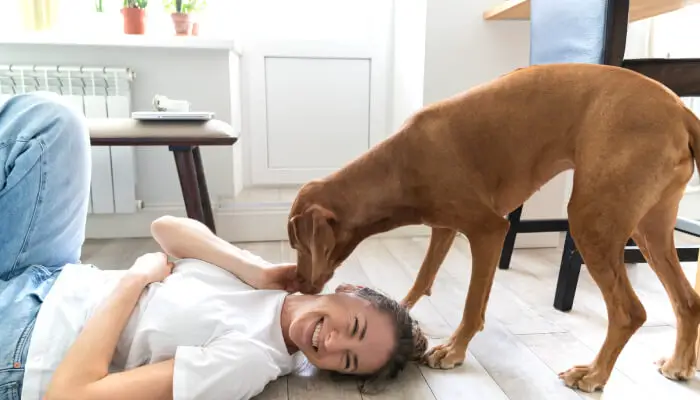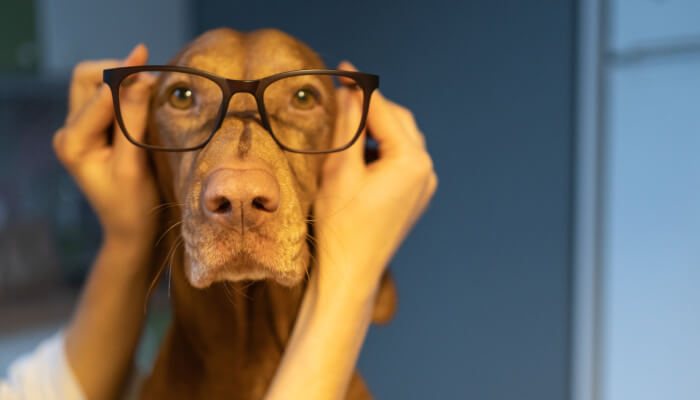Vizsla is a sporting dog that originated in Hungary. Usually, Vizslas are famous for their distinctive long, lean body and short hair, making them easy to care for. However, one of the more hidden secrets about Vizsla is eye problems.
Eye problems in Vizsla can occur due to many things – such as genetic disorders or injury from an accident. But they don’t have to be permanent. For example, the eyes of Vizsla change colors as they grow. So, sometimes, owners think that the color change is due to an eye problem.
Moreover, the signs of eye problems in Vizslas are redness, irritation, or discharge from the eyes. It can also cause cloudy eyes and a change in pupil size. If you notice any of these signs in your Vizsla, it is time to take them to a vet immediately.
We created this blog post with our list of answers to your questions about eye problems in Vizslas.
What Are The Common Eye Problems In Vizsla?
In most cases, eye problems in vizslas occur due to issues of the tear duct. When a vizsla’s eyes become dry and painful and red or inflamed, this indicates the narrowing down of tear-duct and not producing enough fluid for proper lubrication of the eyes.
Here are some of the common eye problems in Vizsla:
Dry Eye And Inflammation
Dry eye in Vizsla is the most common eye problem of all. It typically occurs due to tear ducts that cannot produce enough tears. Usually, this is an autoimmune condition due to thyroid problems as well for example.
If your Vizsla has dry eye and inflammation, it could be a sign of narrowing their tear duct. Moreover, it can happen as the result of an autoimmune condition or even overuse of antibiotics.
Inflammation around the eyes in Vizslas often occurs due to the use of too many painkillers like ibuprofen.
Eye Discharge And Redness In Vizslas/ Conjunctivitis
Eyes with discharge and redness are often a sign of pink eye. It typically occurs due to bacteria or viruses like herpes, adenovirus, erythrocyte proto-parvovirus, and parainfluenza virus in the air we breathe. These viruses can cause conjunctivitis, and it’s essential to keep the area clean by wiping away any discharge.
The redness and inflammation of an eye with a pink-eye virus usually occur when one or both eyes become irritated from contact lenses, dirt particles in the air, allergens such as pollen or pet dander, rubbing them too.
Cloudiness In Vizslas’ Eyes
The cloudiness in a vizsla’s eyes can occur when excessive tearing, inflammation, and dryness. Sometimes the problem is just due to an eye infection or injury which needs medical attention. Usually, this symptom accompanies by redness, sensitivity to light, and squinting.
Cataracts
The most common cause of cataracts in vizslas is as a result of old age. However, cataracts can also occur due to an accident or inflammation resulting from the rupture of blood vessels. You will notice this when there’s a loss in transparency caused by the lens of the eye becoming opaque.
Corneal Degeneration
Corneal degeneration is a hereditary disease prevalent in vizslas. It usually occurs as the dog ages and involves cloudy or opaque corneas, which are responsible for focusing light onto your retina so you can see.
Viral Eye Infection
The most common viral eye infection found in Vizsla dogs is conjunctivitis, which is often a result of a viral illness or bacteria.
Canine Glaucoma
Glaucoma is an eye condition that increases the pressure in the eyeball, causing damage to the optic nerve. Vizsla dogs can develop glaucoma if they have a family history of the state or as a result of aging. The most common cause of glaucoma in Vizslas is an increase in pressure in their eyeballs. However, high blood pressure can also lead to glaucoma, and dog owners need to keep an eye on their pet’s eyesight and be wary if they see any changes.
Distichiasis
Distichiasis is a condition that affects the hair cells of the dog’s upper eyelid. It occurs when too many hairs in this area grow inward, irritating the cornea, which can be painful, especially when contact with your pet.
Canine Entropion
Canine entropion is the most common of all eye problems in Vizslas. It occurs when one or both eyelids roll inward and causes an irregularity on the cornea’s surface, which makes it difficult to see through.
What Causes The Eye Problems In Vizsla?
There are many causes for eye problems in vizslas. One of the most common causes is the obstruction in the tear duct, which can lead to dry eyes and infection.
Sometimes, eye infection can occur from bacteria or viruses, like herpes, adenovirus, erythrocyte protoparvovirus, and parainfluenza virus in the air we breathe. In addition, bacterial conjunctivitis often occurs due to pink eye, which you can quickly treat with antibiotic drops.
Viral infections are also a common cause of infection that can lead to conjunctivitis. The most common reason for vizsla eye problems is usually old age, resulting in cataracts and corneal degeneration. Inflammation from other parts of the body that are not visible in the eyes may also cause eye problems in vizslas.
The cause of eye problems in vizslas is usually hereditary. And it can also be due to an autoimmune condition or allergies, which you can treat through topical therapy with a medicated ointment. However, if the vet does not find any underlying causes for the symptoms, it might be due to old age, and the dog will need surgery.
How To Cure The Eye Problems In Vizsla?
Usually, you can treat eye infections with antibiotic drops, which can help to reduce inflammation and fight off the infection. However, your dog might also need other treatments, such as oral medications or antibiotics if they have an underlying condition like distichiasis or canine glaucoma.
If your Vizsla has corneal degeneration or cataracts, they’ll need surgery to prevent any damage from occurring and so that the dog can see again. You can treat cloudiness in vizslas’ eyes with eye drops to help remove excess water and dry up redness.
Dogs who have corneal dystrophy may require surgery which is an expensive procedure your vet will discuss with you.
How To Prevent Eye Problems In Vizsla?
The best way to prevent eye problems in vizslas is by taking care of their vision and ensuring that you are taking care of them properly as Vizslas age. Be wary if your dog starts squinting or has red eyes. These can be signs of a severe problem.
It’s essential to take care of your dog’s eyes and make sure they are comfortable. A few preventive measures you can do include:
- First, keep their eyes clean by wiping them with a wet cloth.
- Wiping your dog’s face and eyelids with water when you come inside from outside will prevent any debris or bacteria from coming in contact with the eye area.
- The best way to keep your pet’s vision clear is by giving them at least one 30 minute walk a day.
- It’s essential to have your Vizsla examined by a vet every year so that they can spot any problems early on and make sure your pet is as healthy as possible.
Is The Change In Vizsla Eye Color Normal?
No, the change in color of a dog’s eyes is not always regular. Most dogs will show an amber or brown eye, but some vizslas can have blue and silver eye colors too. It’s essential to take your Vizsla for an eye check-up if you notice any changes in
The color of vizsla eyeballs can change as they grow older. Usually, when Vizslas are approaching old age and their vision has started to worsen.
The change in eye color will usually start around the time a vizsla is three years old, but occasionally it may occur earlier than this or later. You should consider your pet’s eyesight if you notice any changes in the color of their
From brown to gold or green dogs, the change in eye color is not uncommon in Vizslas. A few reasons this change could happen, such as genetics or blood flow in the eye.
When Do Vizslas Eyes Change Color?
It’s not uncommon for older vizsla eyes to change color, but it will usually start around age three when they’re approaching old age, and their vision has started.
Conclusion
To close it all up on a good note, Vizslas are a relatively healthy breed of dog with few eye problems. However, if you notice any signs that your pet is not well, it’s essential to take them to the vet as soon as possible for diagnosis and proper treatment.



